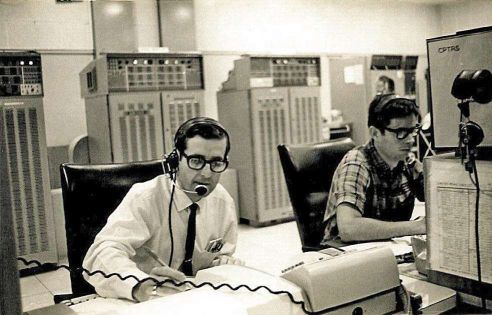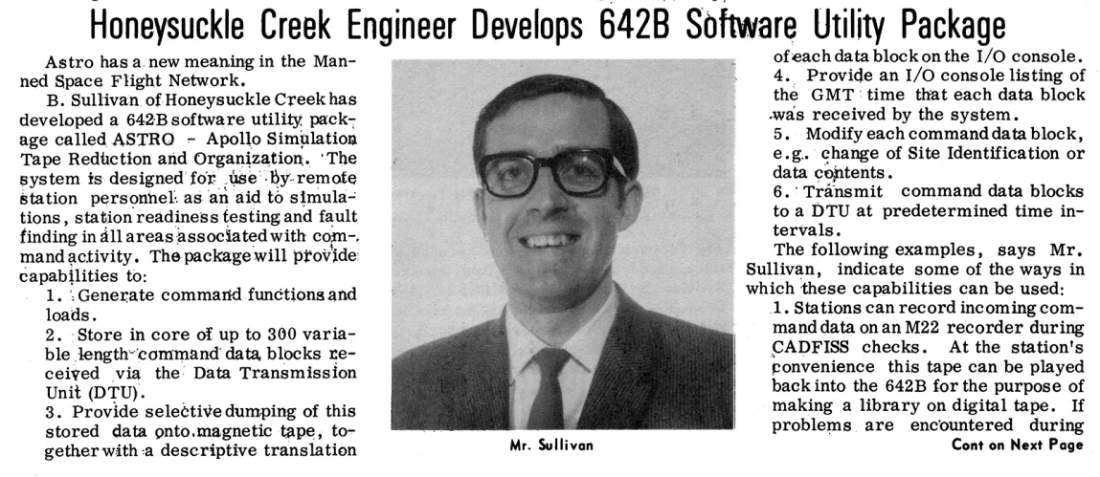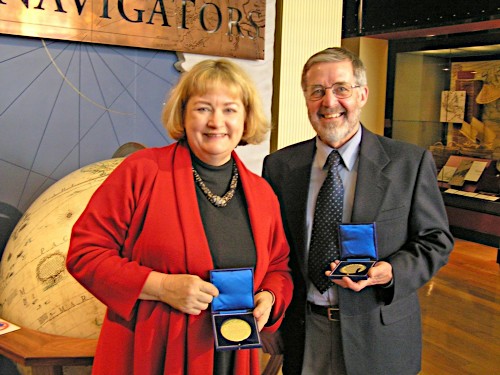
Bryan Sulllivan and Frank Hain (right) during preparations Apollo 12 at Honeysuckle Creek. Apollo 12 was the second manned lunar landing, in November 1969.
Photo and scan: Bryan Sullivan.
Bryan Sullivan
Honeysuckle Creek Computers
 |
Bryan Sulllivan and Frank Hain (right) during preparations Apollo 12 at Honeysuckle Creek. Apollo 12 was the second manned lunar landing, in November 1969. Photo and scan: Bryan Sullivan. |
Bryan Sullivan was born in Sydney in 1939. After completing an electrical trade apprenticeship at the navy dockyards, he graduated from an Electronics and Communications Certificate Engineering course at the North Sydney Technical College (TAFE).
He joined the staff of Weapons Division at the Garden Island Dockyard and worked as an electronics technician on the trials team, testing and tuning ships weapon systems both in the dockyard and at sea. As well as radar and sonar systems he gained experience with electro-mechanical analog computers in the applications of target tracking, prediction and weapon guidance.
He worked as a customer engineer on the early digital computer main-frames with both the Lyons Electronic Office (LEO) and the English Electric companies.
He joined the staff of the military electronics laboratory of EMI P/L in Sydney working on the design and development of digital circuitry for both the IKARA anti-submarine missile and JINDAVIK pilotless jet-aircraft for the RAN.
While at EMI, he and a colleague, Eric Stallard, saw a press advertisement for technical staff for a new space-tracking station near Canberra for the upcoming Apollo project. Their applications were successful and they both moved with their young families to Canberra in 1966.
At the Honeysuckle Creek tracking station Eric was assigned to the Telemetry area and Bryan to the Computer area. Working with Gordon Bendall and Ron Hicks, Bryan began the installation and setting-to-work of the UNIVAC computers and peripheral equipment. They all took advantage of the opportunities to learn to program these computers.
Ron quickly saw inadequacies in some of the UNIVAC utility software, and wrote a far more flexible and enhanced package which he called ZPAC. Gordon, being terribly British, kept referring to it as ‘Zed Pack’ while Ron, being Canadian, insisted that it was ‘Zee Pack’.
The computer memory data registers were labeled Z0, which were referred to as either ‘zed nought’ or ‘zee zero’. Apollo, being an American project, the latter eventually prevailed.
Bryan saw the requirement for a means of monitoring and analyzing spacecraft command data as it was transmitted through the complex hardware uplink path. He developed two diagnostic software suites for the Apollo command system.
ASTRO, which he produced for the 642B computer, proved most useful for monitoring and analyzing the command high speed data during CADFISS testing.
He wrote SABRE for the 1218 computer which was incorporated into the Honeysuckle in-house simulation system. It provided an independent command data source for the normal 642B CMD and TLM computer mission configurations.
Bryan attended the first course in computer programming held in the U.S. at the Network Test and Training Facility at GSFC (the Goddard Space Flight Center, Greenbelt, Maryland) in 1969 which covered the software assemblers and compilers used in the UNIVAC military computer systems.
 |
Bryan’s work was recognised in the Network Technical Information Bulletin from Goddard – published on the day Apollo 11 landed on the Moon. Click for a PDF file of TIB Volume 6, Number 11. |
Bryan was on-duty at the computer consoles during Apollo 11 when Neil Armstrong
stepped onto the lunar surface and also at that moment during Apollo 13 when
an oxygen tank exploded on the spacecraft. Although Apollo 13 was his most operationally
challenging and technically frustrating mission as they battled with an elusive
computer problem, his time
on the station operations console as an OPS2 for the duration of the Apollo
16 mission was his most memorable.
Bryan left Honeysuckle after the final SKYLAB mission in 1974 with an excellent background in computer communications and real-time systems software.
He went on to work in commercial data processing with the ACT Totalizator Agency Board, and the Canberra Building Societies in the development of real-time on-line transaction data processing which heralded the introduction of the now very familiar ‘hole-in-the-wall’ banking.
Returning to military
applications in 1980, Bryan participated in a major software upgrade project
for the RAN Naval Tactical Data System. He also worked on a management information
system and an integrated logistics support system for RAN submarines. Bryan
was a member of the Project Definition Study Team in Europe for the Collins
Class submarine project. Bryan says that a submarine is a very similar platform
to a spacecraft as they both take humans beyond the limits of their normal environment.
In 2005, Bryan, with his wife Jackie, wrote the award winning children’s
book To the Moon and Back
which tells the story of Honeysuckle Creek and the role of Australians in getting
the astronauts to the moon and back. The book is dedicated to the grandchildren
of the staff of the Honeysuckle Creek Tracking Station.
Bryan ‘retired’
in 1990 to the Araluen Valley in NSW where he and Jackie enjoy an alternative
rural lifestyle. Growing fruit and vegies, living in a stone cottage that Jackie
built, they harvest energy from both the sun and the creek to power their house
via solar panels and generate hydro electricity from Bryan’s home made
water wheel.
|
Jackie and Bryan in Sydney after their book ‘To the Moon and Back’ was awarded Children’s Book of the Year in the Information Books category in 2005. Photo: Colin Mackellar. |
See also: Interview with Bryan Sullivan – including his reflections on Apollo 11. |
